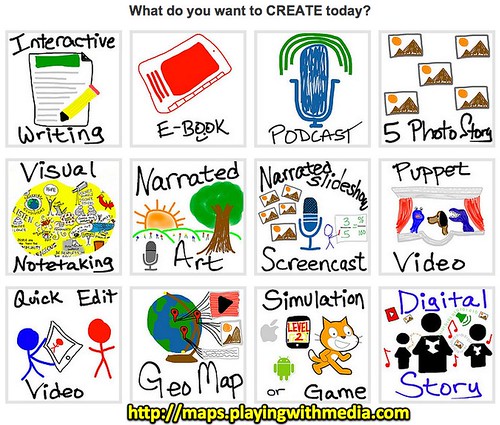We live in a highly distractible era. Some people’s reaction to our world of always-on communication, mobile phones and digital interruptions is to say: “Let’s turn everything off! Let’s throw it all out!” That is the response and message in the humorous book/video, “Goodnight iPad” by Ann Droyd. I used that video a couple of weeks ago with teachers in Bethany, Oklahoma, to discuss the ways we should (or should not) respond to technology in our homes as well as classrooms.
The four minute video, “What the Internet is Doing to Our Brains,” provides an insightful perspective into more of these issues involving multi-tasking, distractions, and transfer of ideas from short-term to long-term memory. It primarily references Nicholas Carr’s book, “The Shallows: What the Internet Is Doing to Our Brains.” One of the main points of the video is that we need to find uninterrupted time to focus on single tasks if we want to learn deeply. This reminds me of Flow Theory by Csikszentmihalyi. In today’s distractible environment, it’s far easier to mentally jump from one thought to the next rather than spend time concentrating on a single task for a long period of time. This has important implications for creativity, innovation, and long-term memory transfer of ideas. Give the video a watch, it’s worth it.
One of the connections I made in this video is that it supports the goal of students CREATING MEDIA to show what they know and understand from the school curriculum. When we create a tangible knowledge product, we are required to focus our attention for a longer period of time on a defined task. There are no magic bullets, simply “creating a digital knowledge product” in class doesn’t address the multitude of challenges which beset teachers and students at school, but it CAN be an effective way to help students manage distractions and focus for longer periods of time. That, in turn, can lead to more in-depth learning and more beneficial educational experiences. (Marzano et. al, 2003)
A key element in this process is ASKING GOOD QUESTIONS. Last fall, during testing time, I helped a 7th grade geography teacher plan and teach a 3 day lesson culminating in “Paper-Slide Videos” filmed by students using their BYOD smartphones. While the process of encouraging students to create those videos was good and beneficial, I was still struck by how “shallow” some of their thinking was about their topics. Students had been studying Africa, and each group took a different topic. Some of the videos seemed to reflect very little deep or original thinking, and it made me wonder how different their videos would have been at the START of the lesson study compared to the end? Hopefully through the course of their studies they’d been challenged to think more deeply about ideas and issues, but I honestly don’t think that happened in many cases. Students are very used to filling in the blanks, searching for and regurgitating the “expected answer” on demand. Situations which call for deep thinking and/or original thoughts can be rare in the classroom. When we think about the more rigorous and demanding expectations of the Common Core State Standards, we need to think not only about media products our students can create but perhaps more importantly, the TIME we will take to both ask and answer deeper questions which authentically challenge us to move beyond our pre-existing perceptions and ideas.
I’d love to see more professional development workshops at schools and educational conferences about helping students and teachers ask good questions. Admittedly, my thoughts about this are strongly colored by my current re-reading of Neil Postman and Charles Weingartner’s fantastic 1969 book, “Teaching As a Subversive Activity.” On page 49 they lament how some teachers force their students to play “Let’s Pretend” in class and call it learning. They wrote:
The game is based on a series of pretenses which include: Let’s pretend that you are not what you are and that this sort of work makes a difference to your lives; let’s pretend that what bores you is important, and that the more you are bored, the more important it is; Let’s pretend that there are certain things everyone must know, and that both the questions and answers about them have been fixed for all time; let’s pretend that your intellectual competence can be judged on the basis of how well you can play Let’s Pretend.
The video I’ve embedded / linked above and these words from Postman and Weingartner challenge me as a teacher to find ways to help students engage meaningfully in studies and investigations in which they find personal connections and relevance. As a teacher, I can help students make those connections, but it’s critical I don’t assume the connections will be there naturally (since “it’s in the textbook” or “it’s in our curriculum”) or fail to provide needed time to make those connections. These kinds of challenges have been with teachers and students for decades, since the dawn of the “formal curriculum.” What is different and new today, however, is the ease with which all of our minds can become distracted. Smartphones in everyone’s hands (or the growing ubiquity of mobile phones, to use a less-sweeping generalization) make this reality quite visible in our classrooms today and society more generally.
Distractions can be an enemy of deep thinking and focus, and technology is often perceived to be at odds with those goals.
These are yet more reasons why we need to help students effectively communicate using a variety of multimedia products, but also work hard to ensure our focus is guided by deep and meaningful questions worth answering as well as discussing.
H/T to my mom for sharing this video on Twitter, via the August 10th article, “What The Internet Does To Your Mind.”
Technorati Tags: edtech, technology, shallows, internet, distraction, focus, create, media, mapping, multimedia
If you enjoyed this post and found it useful, subscribe to Wes’ free newsletter. Check out Wes’ video tutorial library, “Playing with Media.” Information about more ways to learn with Dr. Wesley Fryer are available on wesfryer.com/after.
On this day..
- Setting Up an iPad Cart [VIDEO] – 2014
- The iCloud Cometh – 2011
- Guest blogging is like going on vacation! – 2010
- Comparing Worldbook Encyclopedia 2008, WikiPedia, and Digital Stories – 2009
- My Dell Mini 10V Netbook with Ubuntu is on the way – 2009
- QuickStart Guide for Internet Research with Google Notebook – 2008
- Promote visual literacy and extend learning with a photo contest – 2007
- Christmas in August! – 2006
- Kerryoniraq.com, Digital Storytelling on the political scene – 2004
- Great suggestions for daily prayer life – 2004






Comments
2 responses to “Managing Distractions: Maintaining Focus and Creating Media”
[…] one about managing technology use and how technology can be distracting. That post can be viewed here. I found this to be really interesting. He posted a video that you can see here… I highly […]
Linked my article about creativity and learning to here! Useful stuff, thanks. You can see it here:
http://blog.no57boutique.com/2015/06/12/developing-your-creativity-part-4-being-determined-to-learn/